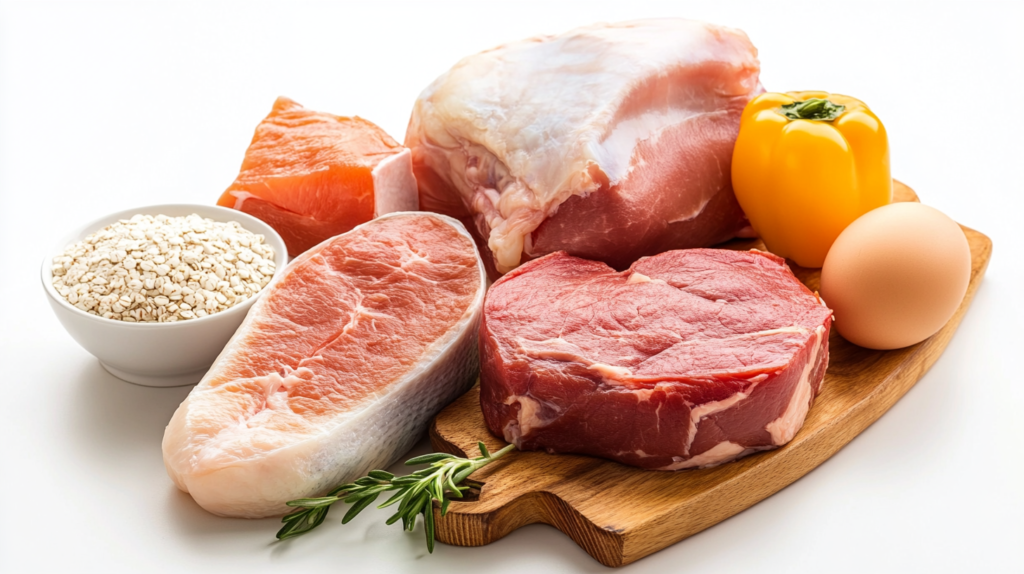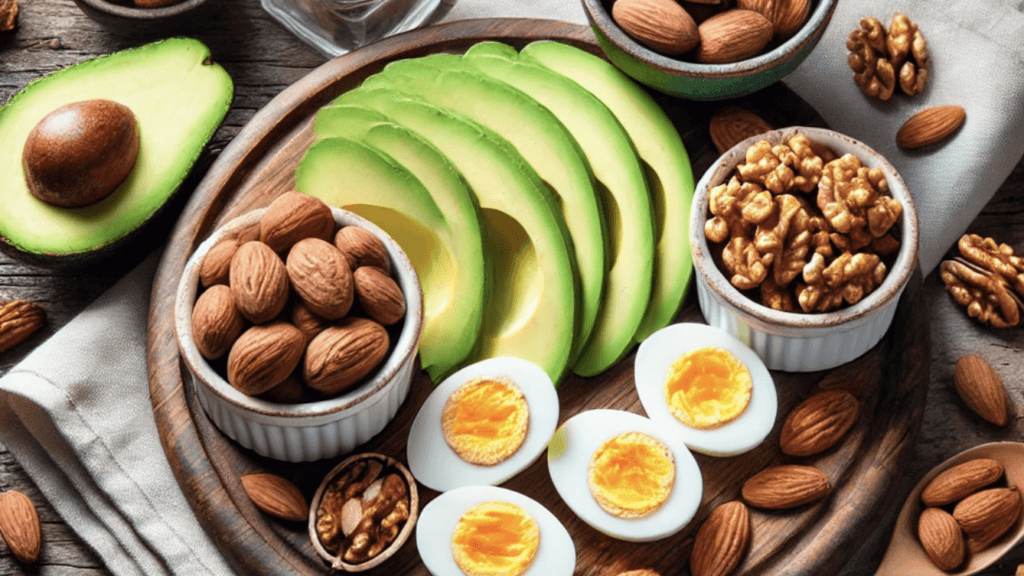Last updated on May 10th, 2025
Are you looking for a sustainable and delicious way to improve your health? Low carb food has become a cornerstone for many diets due to its versatility and remarkable benefits.
During many years of practice as a CHEF in a Famous Restaurent I have made many recipes with low carb while incorporating protein rich foods, healthy fats, and fiber packed vegetables. Whether you’re seeking weight loss, better blood sugar control, or a more balanced diet, low carb eating provides a pathway to success.
In this guide, we’ll cover the essentials of low carb foods, their benefits, and practical ways to integrate them into your daily life.
Table of contents
What Are Low Carb Foods?
Low carb foods are those with minimal carbohydrate content, allowing your body to rely more on fat and protein for energy. They’re a cornerstone of popular diets like keto and Atkins. Here are some examples:
- Proteins
- Examples: Chicken, turkey, beef, seafood (salmon, tuna, shrimp), and eggs.
- Benefits: Provide essential amino acids and help maintain muscle mass.
- Vegetables
- Examples: Broccoli, spinach, zucchini, kale, and cauliflower.
- Benefits: Rich in fiber, vitamins, and minerals, with minimal carbs.
- Healthy Fats
- Examples: Avocado, olive oil, nuts (almonds, walnuts), and seeds (chia, flax).
- Benefits: Enhance satiety and support brain function.
Benefits of Low Carb Food
The advantages of adopting a low carb lifestyle go far beyond weight loss. From improving heart health to stabilizing blood sugar levels, here’s why low carb food deserves a place in your diet:
Effective Weight Loss
Low-carb diets are widely recognized for their ability to promote sustainable weight loss. By reducing carbohydrate intake, the body turns to fat stores for energy, encouraging fat burning. Additionally, stabilizing insulin levels a key hormone that regulates fat storage helps reduce cravings and prevents overeating. This makes it easier to stick to a calorie deficit, a fundamental aspect of weight management.
Research suggests that low carb diets are particularly effective in targeting visceral fat, which accumulates around internal organs and is linked to health risks. Unlike traditional calorie restricted diets, a low carb approach often feels more satisfying, leading to better long term adherence.

Improved Blood Sugar Control
One of the most significant benefits of a low carb lifestyle is its positive impact on blood sugar regulation. Reducing carbohydrate intake minimizes glucose spikes and keeps blood sugar levels stable throughout the day. This is especially beneficial for individuals managing diabetes or prediabetes.
By focusing on foods with a low glycemic index, such as leafy greens, nuts, and proteins, a low carb diet reduces the body’s demand for insulin. This can improve insulin sensitivity over time, lowering the risk of complications associated with high blood sugar levels. For those already managing diabetes, adopting a low carb diet may reduce the need for medications or insulin therapy, though this should always be done under medical supervision.
Enhanced Heart Health
Low carb diets offer a range of heart health benefits. By lowering triglycerides a type of fat found in the blood they significantly reduce one of the key risk factors for cardiovascular disease. Additionally, these diets are known to increase levels of HDL cholesterol, often referred to as the “good” cholesterol, which helps remove harmful cholesterol from the bloodstream.
Emerging studies suggest that low carb eating may also lower inflammation markers in the body, further supporting cardiovascular health. Paired with healthy fat sources like avocados, olive oil, and nuts, a well balanced low carb diet can have a profound positive impact on long term heart health.
Increased Satiety
Low carb meals, often rich in protein and healthy fats, provide a level of satiety that’s difficult to achieve with high carb alternatives. Protein and fats take longer to digest than carbohydrates, keeping you feeling full and satisfied for extended periods. This can naturally reduce the tendency to snack between meals and helps maintain steady energy levels throughout the day.
For those trying to manage their weight or avoid the energy crashes associated with sugary foods, low carb meals are an effective solution. Foods like eggs, fatty fish, and nut butters deliver a nutrient dense punch that keeps hunger at bay while providing essential vitamins and minerals.

Examples of Low Carb Food
1. Protein Packed Foods
Protein is vital for building and repairing tissues while keeping you energized. Include these options in your meals:
- Meat and Poultry: Lean cuts of chicken, turkey, and beef are low in carbs and high in protein.
- Seafood: Fatty fish like salmon and mackerel offer omega 3s along with protein.
- Eggs: A staple for any low carb meal, eggs are versatile and nutrient rich.
2. Non-Starchy Vegetables
Vegetables are a must have for low carb diets. They’re not only nutritious but also add variety and texture to your meals:
- Broccoli and Cauliflower: Perfect for roasting or as rice substitutes.
- Zucchini: Spiralize it to make low carb noodles.
- Spinach and Kale: Use them in salads, smoothies, or sautéed as a side dish.
3. Low Carb Fruits
While most fruits are high in natural sugars, these options are excellent for a low carb diet:
- Berries: Blueberries, raspberries, and strawberries are packed with antioxidants.
- Avocados: Rich in healthy fats and fiber.
- Tomatoes: A versatile fruit for salads, sauces, and more.
4. Healthy Fats, Nuts, and Seeds
Incorporating healthy fats is crucial for energy and satisfaction:
- Nuts and Seeds: Almonds, walnuts, chia, and flaxseeds are great for snacking or meal additions.
- Oils: Olive oil and coconut oil are ideal for cooking and dressings.
How to Build a Low Carb Meal Plan
Creating a balanced low carb meal plan ensures you get all the nutrients your body needs while enjoying delicious foods. Here’s a sample:
- Breakfast: A spinach and cheese omelet with avocado slices.
- Lunch: Grilled chicken salad with olive oil and lemon dressing.
- Dinner: Baked salmon with roasted broccoli and cauliflower rice.
- Snacks: Hard boiled eggs, almonds, or veggie sticks with guacamole.
Meal prepping in advance can save time and help you stick to your dietary goals.
Frequently Asked Questions About Low Carb Food
Low carb diets can be incredibly effective for weight loss, improving blood sugar control, and overall health. However, many people have questions about what foods they can eat, how to structure their meals, and how to make a low carb diet sustainable. Here are answers to some of the most commonly asked questions about low carb eating.
What foods can you eat on a no carb diet?
A no carb diet is a highly restrictive version of low carb eating. It eliminates nearly all carbohydrates, focusing on foods like:
- Proteins: Meat, poultry, fish, and eggs are staples of a no carb diet.
- Fats: Healthy fats like olive oil, butter, and avocado oil are essential energy sources.
- Low Carb Vegetables: Leafy greens, cucumbers, and zucchini are some of the few vegetables low enough in carbs to fit into a no carb plan.
- Cheese and Other Dairy: Hard cheeses, cream, and full fat yogurt are options as long as they are unsweetened.
The challenge of a no carb diet lies in avoiding foods with even small amounts of carbohydrates, such as fruits, most vegetables, grains, and legumes. While it’s possible to follow a no carb plan, it requires strict adherence and planning to avoid nutritional deficiencies.
What is the most filling low carb food?
One of the biggest benefits of low carb diets is their ability to keep you full and satisfied. The most filling low carb foods include:
- Eggs: High in protein and healthy fats, eggs are versatile and satiating.
- Avocados: Packed with healthy fats and fiber, avocados are a filling addition to any meal.
- Fatty Fish: Salmon, mackerel, and sardines provide protein and omega 3 fatty acids, which help keep hunger at bay.
- Nuts and Seeds: Almonds, walnuts, chia seeds, and flaxseeds are nutrient dense and provide a good balance of protein, fat, and fiber.
These foods not only keep you full longer but also provide essential nutrients to support overall health.
Which foods are low in carbs?
Many foods are naturally low in carbohydrates and can be the foundation of a low carb or keto diet. Examples include:
- Vegetables: Non starchy vegetables such as spinach, kale, broccoli, cauliflower, bell peppers, and zucchini.
- Proteins: Chicken, beef, pork, fish, and eggs are all carb free or very low in carbs.
- Dairy: Hard cheeses, cream, unsweetened Greek yogurt, and butter.
- Healthy Fats: Olive oil, coconut oil, avocado, and nuts.
These foods are not only low in carbs but also packed with nutrients, making them excellent choices for maintaining a balanced and sustainable diet.
What not to eat on a low carb diet?
To stick to a low carb diet effectively, certain foods should be avoided because they are high in carbohydrates and can interfere with your goals. These include:
- Sugary Foods: Cakes, cookies, candies, sodas, and other sweetened drinks.
- Grains and Starches: Bread, pasta, rice, and potatoes are rich in carbs and should be limited or eliminated.
- High Carb Fruits: Bananas, mangoes, grapes, and pineapples are high in natural sugars and should be consumed in moderation, if at all.
- Processed Foods: Chips, crackers, and most packaged snacks often contain hidden sugars and refined carbs.
Avoiding these foods will help keep your carbohydrate intake low and make it easier to achieve your health and weight goals.
What are low carb snacks?
Low carb snacks are an excellent way to maintain energy and prevent hunger between meals. Some great options include:
- Hard boiled eggs
- Cheese slices or cheese sticks
- Nuts like almonds, walnuts, or pecans
- Seeds such as sunflower or pumpkin seeds
- Veggie sticks (e.g., celery, cucumber, or bell peppers) paired with hummus or guacamole
These snacks are not only convenient but also nutrient dense, making them ideal for busy lifestyles.
How many carbs can I eat on a low carb diet?
Most low carb diets recommend consuming 20–50 grams of carbohydrates per day. However, this range can vary depending on your specific goals:
- Weight Loss: For aggressive fat loss, staying closer to 20–30 grams of carbs daily is often recommended.
- Maintenance or Athletic Performance: If you’re maintaining your weight or require more energy for workouts, you can aim for 50–100 grams of carbs daily.
Tracking your carb intake can help ensure you’re staying within your target range and achieving your goals.
Are low carb diets sustainable?
Yes! With proper planning and variety, low carb diets can be a long term lifestyle choice. Incorporating a wide range of proteins, fats, and vegetables ensures you don’t feel restricted or bored. Additionally, occasional indulgences can be managed by cycling higher carb days or finding low carb alternatives to your favorite foods.
Do I need to track calories on a low carb diet?
Many people naturally consume fewer calories on a low carb diet due to the satiating effects of protein and fats. However, if weight loss is your primary goal and progress stalls, tracking calories may help identify areas where you can adjust portion sizes or balance your macronutrient intake.
By understanding these aspects of low carb eating, you can make informed decisions and enjoy a diet that supports your health, energy, and lifestyle.
Practical Tips for Adopting a Low Carb Diet
Transitioning to a low carb diet doesn’t have to be overwhelming. Here are some practical tips:
- Plan Your Meals
Preparing meals in advance reduces the temptation to reach for high carb options. - Read Labels Carefully
Be mindful of hidden sugars and carbs in packaged foods, even those marketed as “healthy.” - Experiment with Substitutes
- Use cauliflower rice instead of traditional rice.
- Try almond flour or coconut flour as alternatives to wheat flour.
- Replace pasta with zucchini noodles.
- Stay Hydrated
Drink plenty of water, as low carb diets can lead to initial water loss. - Start Slowly
Gradually reduce your carb intake to allow your body to adjust to the change.
Conclusion
Adopting a lifestyle centered around low carb food is a sustainable way to improve your health and well being. By focusing on proteins, vegetables, and healthy fats, you can create satisfying and nutrient rich meals. The key is to find recipes and strategies that work for your taste preferences and lifestyle.

